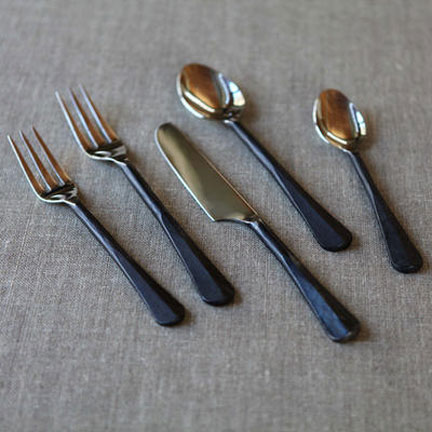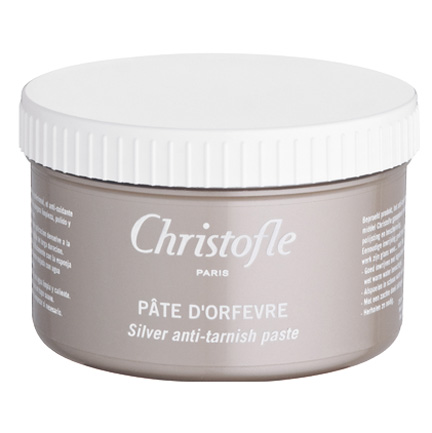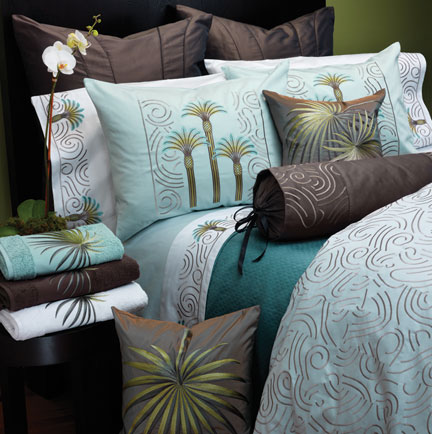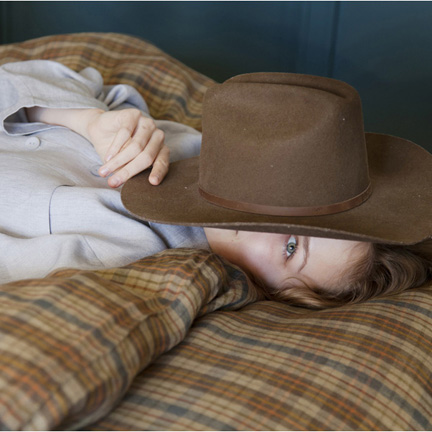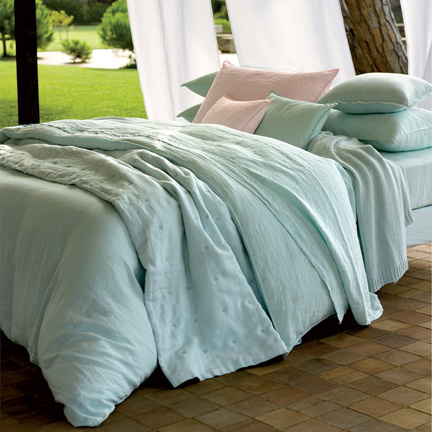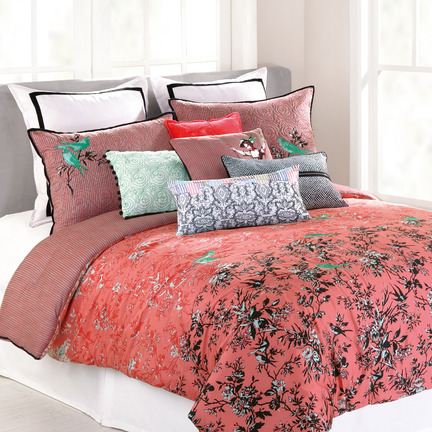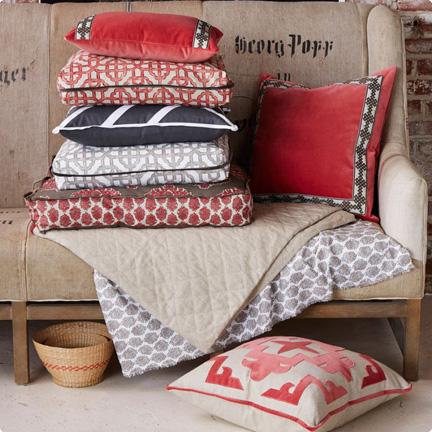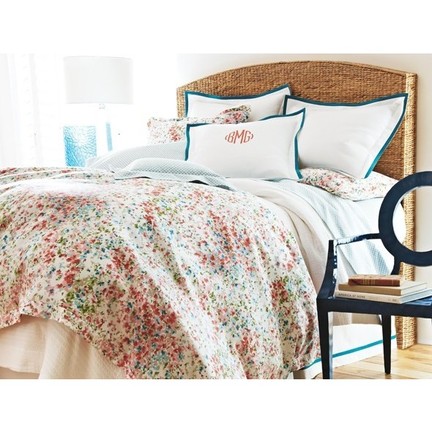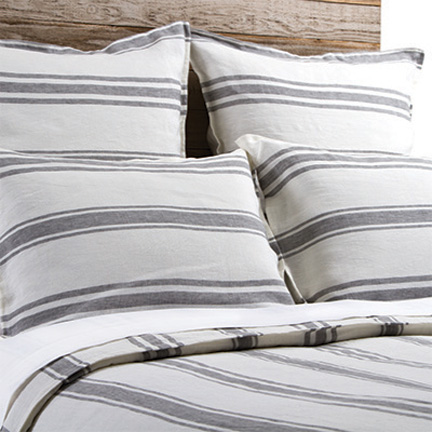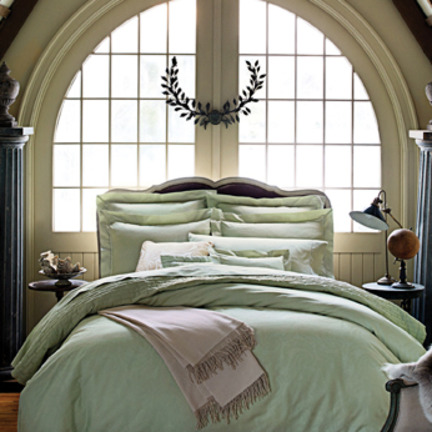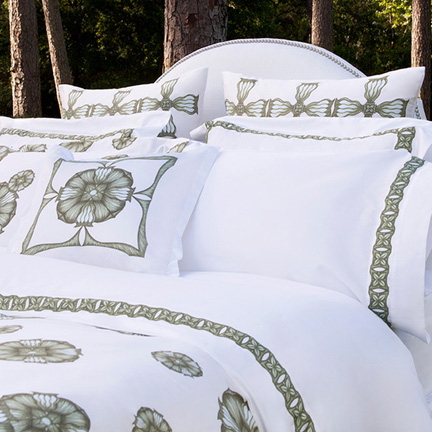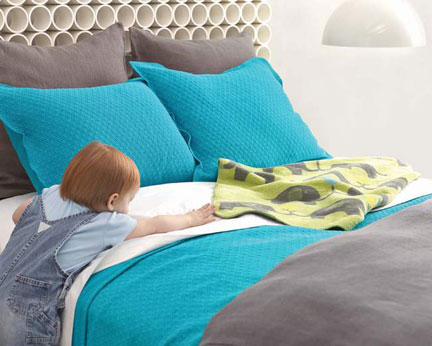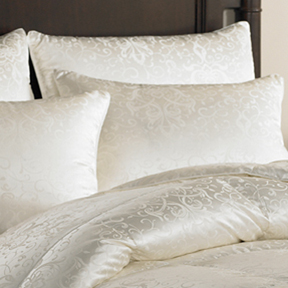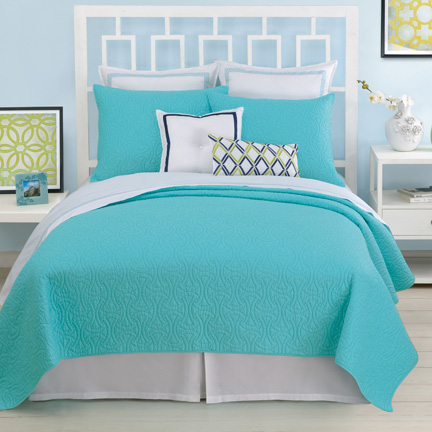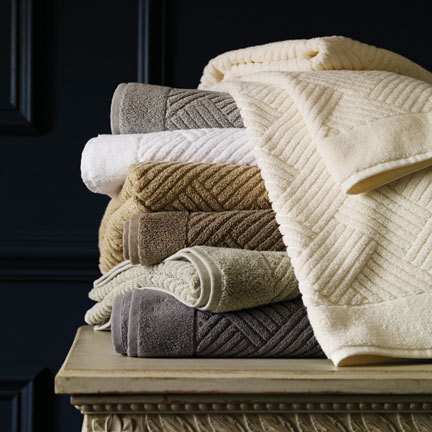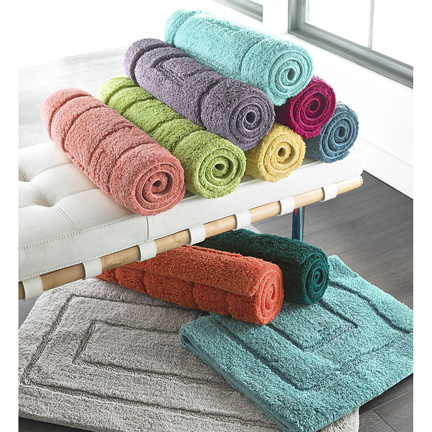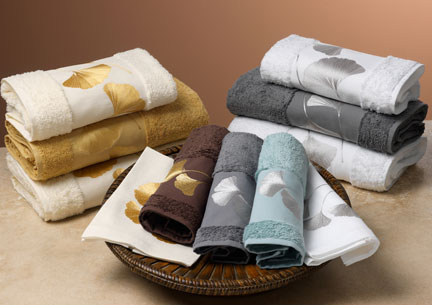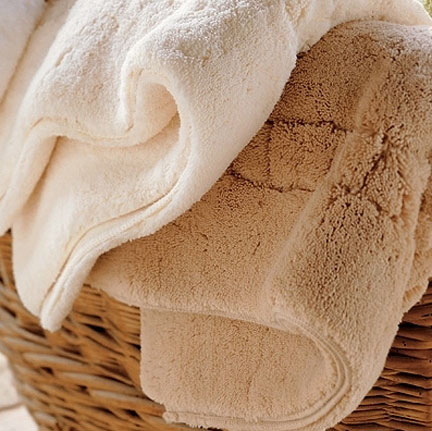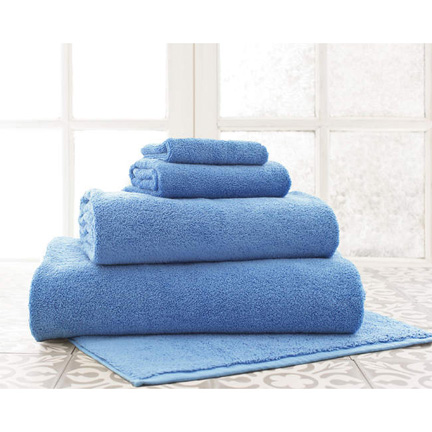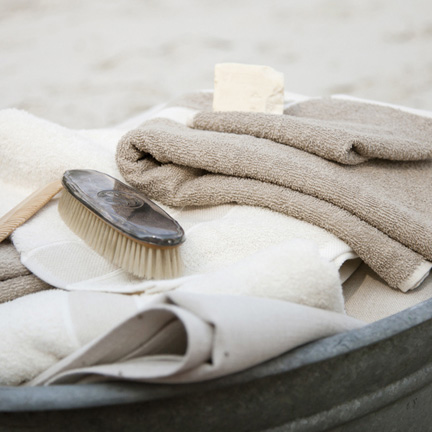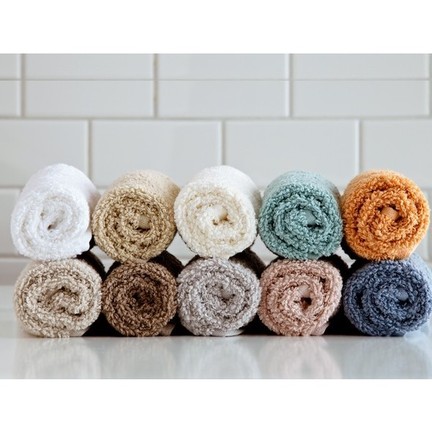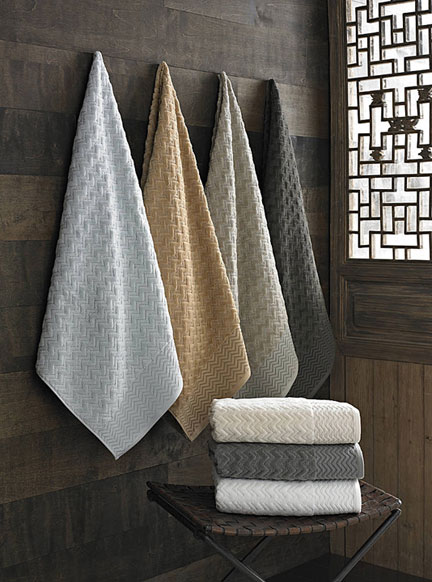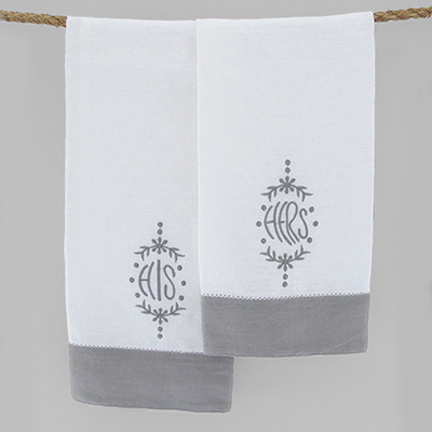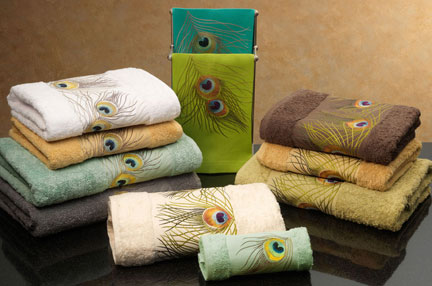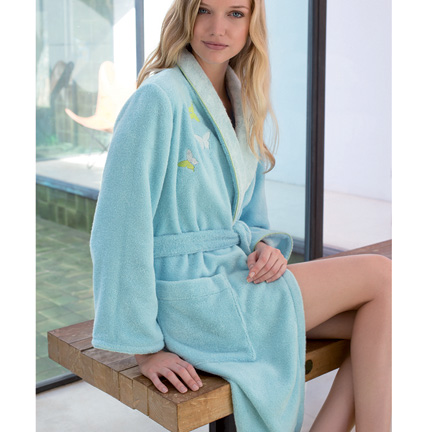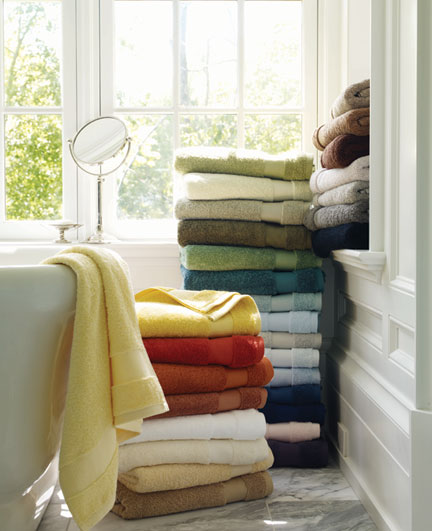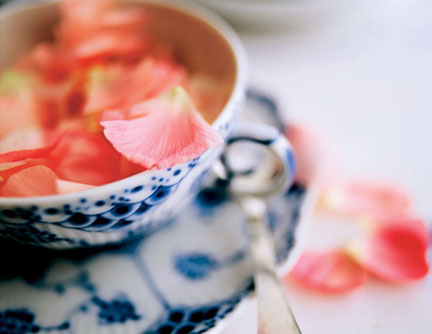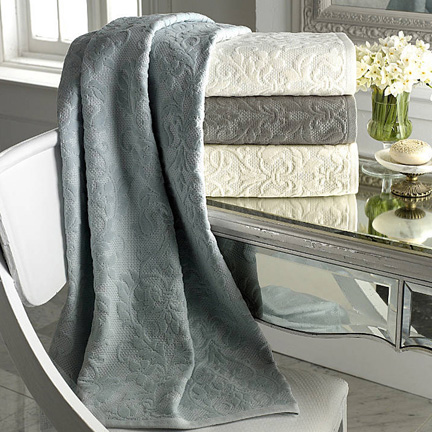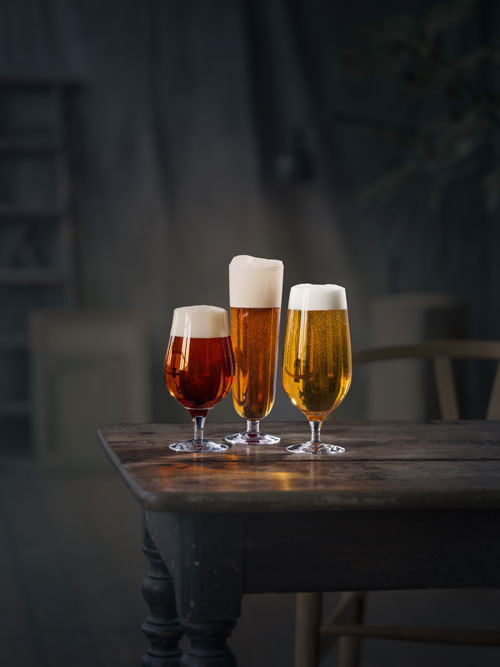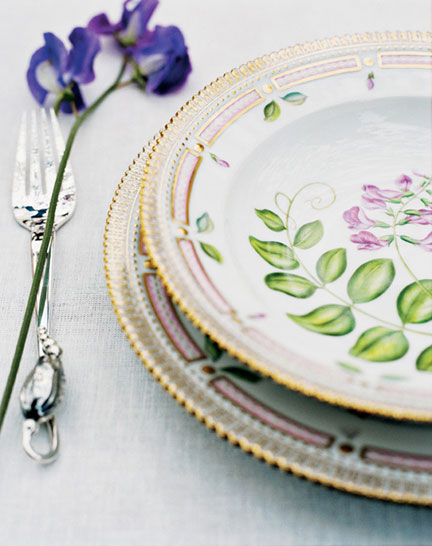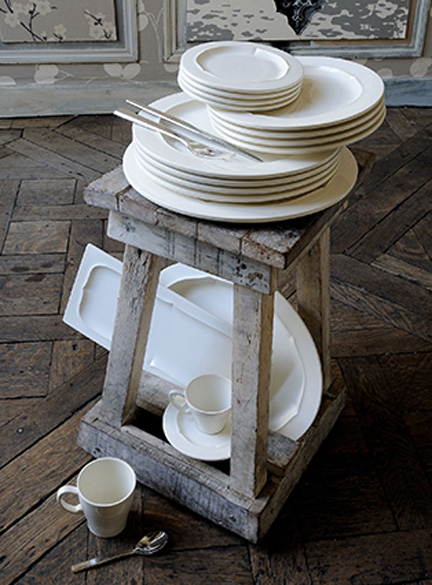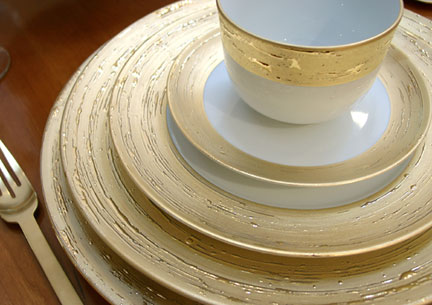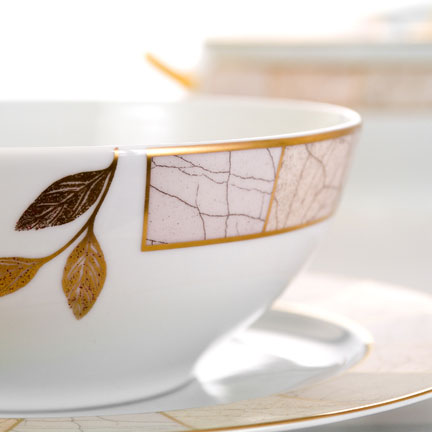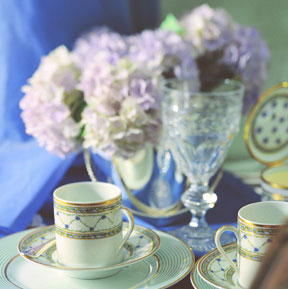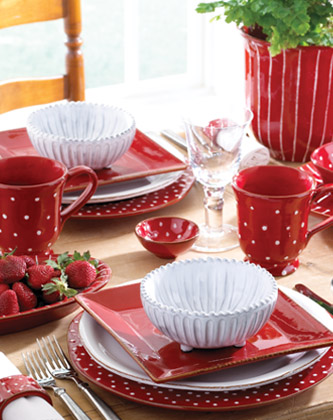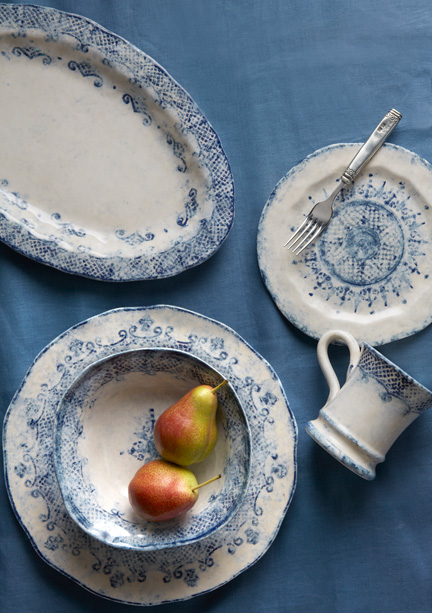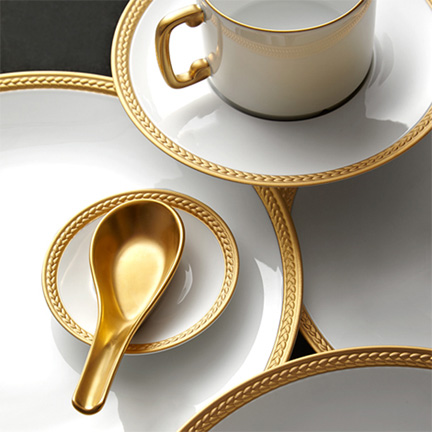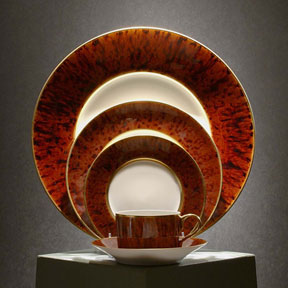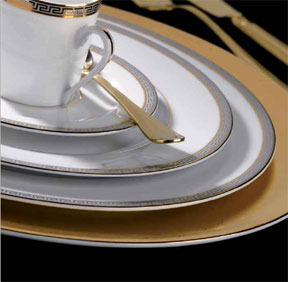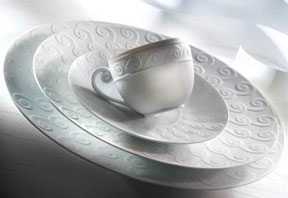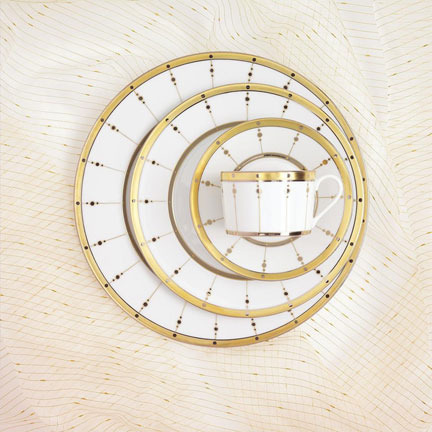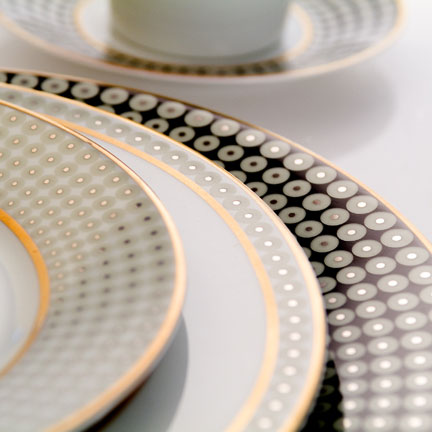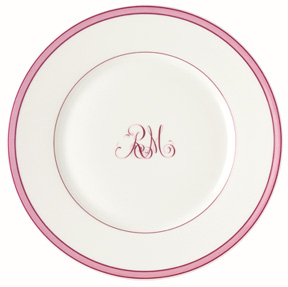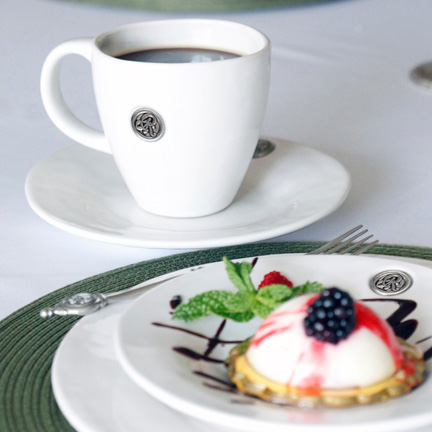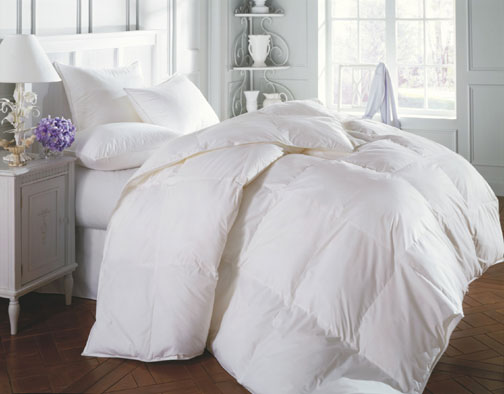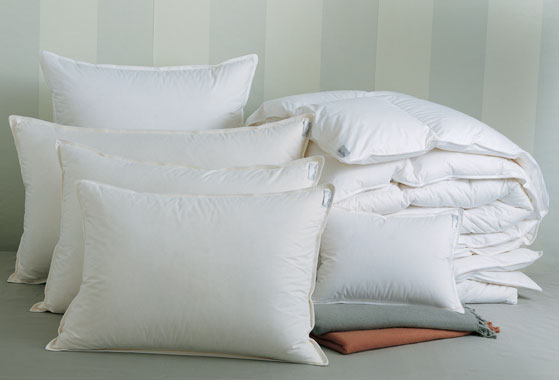Save to...
Guide to Choosing Flatware
There are so many exciting choices in flatware, you are probably asking yourself, “Where do I start? Which material should I select, and how many pieces will I need?” We break down the basics for you, so your table will look fabulous in no time flat.
Understanding Flatware Materials
What are the different types of materials used to make dinnerware?
Sterling: Sterling silver flatware collections are true heirlooms. Sterling is made of at least 92.5% pure silver and an alloy (usually copper for added strength). Any piece of flatware that meets these guidelines is stamped with the word “sterling” to ensure its authenticity. Sterling silver is very expensive, but it makes the most elegant and formal flatware. Compared to stainless, sterling has a warmer glow and may require occasional polishing. When not in use for prolonged periods, we advise keeping sterling in felt pouches to prevent scratches or tarnish.
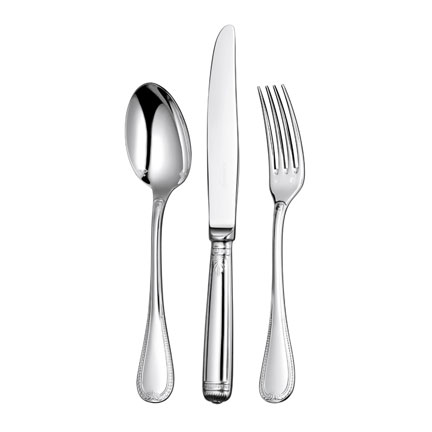
Silverplate: Silverplate is a dishwasher-safe, less-expensive alternative to sterling that can last nearly as long. A layer of 100% silver coats another metal, usually nickel or brass. Nickel is best, because it’s harder than brass and silver adheres to it well. The thicker the silver layer, the better the quality.
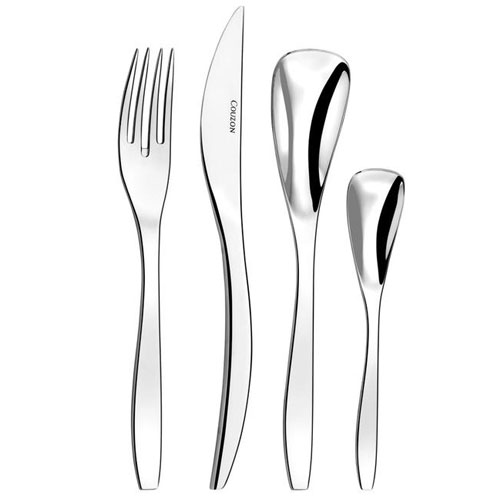
Stainless Steel: Most everyday flatware is stainless steel, which doesn’t rust, tarnish, chip, or wear out. Stainless steel is commonly defined as a metal alloy that contains a minimum of 10.5% chromium. To make stainless steel flatware, chromium is added to steel for strength as well as rust and stain resistance. Nickel, another metal alloy, is also added to the steel for its brilliance and lasting finish. The grades (18/10, 18/8, and 18/0) refer to the amount of nickel, which prevents corrosion. The best grade is 18/10, because it is the longest lasting.
Why is stainless steel “stainless”?
Compared to other metals, stainless steel is particularly resistant to rust and discoloration because the oxide film in the metal absorbs common forms of discoloration. Keep in mind, however, that while stainless steel certainly stains less, it is not completely stain proof.
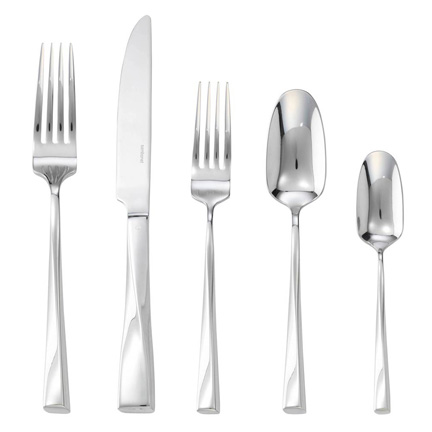
Pewter: In colonial America, pewter was prized for its strength and durability. Today, pewter products are sought after by collectors for their rustic feel and beautiful patina. Pewter does not require polishing.
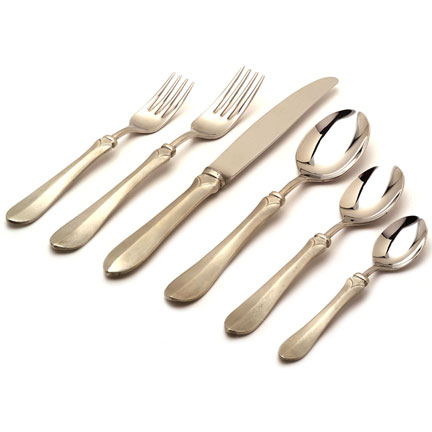
PVD: Is a thin ceramic coating deposited on stainless steel pieces, resulting in colored implements. It is very hard and resists abrasion well.
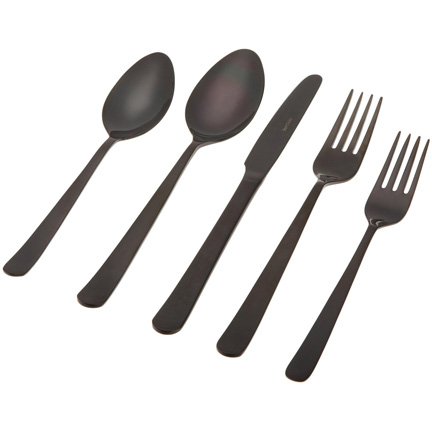
Acrylic: Acrylic flatware with colored and patterned handles is sold in a rainbow of styles. Fashionable enough for formal events, it’s also great for everyday use. Q Squared’s London Chic collection, and Vietri’s best-selling Aladdin collection, are perfect for adding personality to your table setting.
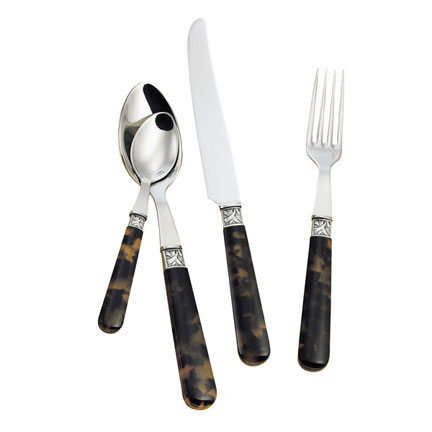
Suggested quantities
What is included in a five-piece setting?
Five-piece place settings consist of the following: dinner knife, dinner fork, salad fork, tablespoon and teaspoon.
Can I order additional flatware pieces?
Yes. In addition to five-piece settings, additional pieces such as butter spreaders, fish forks and knives, demitasse spoons, salad servers, cake servers and gravy ladles are standard items in many collections. Please write us at service@graciousstyle.com for further information on any of our collections.
How many flatware collections do I need?
Generally, most people have at least one casual collection for everyday use (usually stainless steel) and one formal collection for selected occasions (usually sterling or silverplated).
What serving pieces do I need?
– Twelve five-piece settings
– One serving set (serving knife and serving fork)
– One salad serving set
– One carving set
– One set of steak knives
– One cake server
Caring for Flatware
How do I care for stainless steel flatware?
Stainless steel flatware is dishwasher safe; it can also can be washed by hand.
How do I care for silverplated or sterling flatware?
The best way to keep sterling and silverplated lustrous is to use it regularly. For optimal care, wash silver flatware in hot water with mild soap and dry immediately afterward with a soft cloth. Do not wash sterling and stainless together, as the steel will scratch the silver. Use a small amount of detergent, and one with no lemon or citrus additives.
To clean individual pieces of silver, you can use a high-quality silver polish or foam (such as Christofle Cream Cleaner with Sponge). To view all our metal cleaning products and storage cases, click here.
However, to clean many pieces simultaneously, we suggest the following quick-clean method:
1) Boil a pot of medium pot of water.
2) Line a pan with aluminum foil.
3) Place your flatware pieces inside the pan, one next to each other.
4) Pour boiling water over the flatware.
5) Add a few tablespoons of baking soda to your pan. While the solution bubbles up, watch the tarnish disappear from your flatware and onto the aluminum foil. Try this, it really works!
How do I store my flatware?
We recommend that you enjoy your flatware as much as possible. However, when not in use, flatware can be stored in a kitchen drawer (designated for this use) or kept inside felt bags. Do not wrap in plastic or paper, and do not crowd pieces to avoid scratching.

Miscellaneous
What is the difference between standard and continental sizes?
Standard refers the sizes of flatware commonly used with American table settings. However, for a more formal look, there are “continental” flatware sizes (also referred to as “dinner” sizes) that are larger and heavier than the standard. These are usually found in European flatware collections.
What is the proper placement of flatware on the table?
A basic five-piece setting is laid out on the table in order of use, in an even line, one inch from the edge of the table. The knife is placed to the right of the plate with the sharp edge pointed in towards the plate. The spoons are placed to the right of the knife. Forks are placed to the left of the plate. In France the fork is placed with the prongs facing down towards the table (the spoons are also placed facing downward); in the United Kingdom and the United States they face upwards.

To view all our collections of flatware, click here.
Guide to Choosing Bed Linens
We typically spend a third of our lives in our bedroom, so be sure to get a set of linens you’ll love using over and over again.
Understanding Bedding Materials
What should I look for in finer linens?
Finer linens are usually characterized by a combination of beautiful materials, expert construction, and design. Most fine linens are made from linen or cotton because they are durable, absorbent, and they become softer with use and laundering.
Finer linens are smooth and soft (no coarse knots or uneven slubs should be visible); they may also be lustrous, but never shiny. Workmanship is key: all designs must be precisely executed, all colors uniform, and all seams must be finished evenly to ensure they’ll last for years.
What is the difference between linen and cotton?
Both linen and cotton are natural fibers: linen comes from the flax plant and cotton comes from the cotton plant. Both fabrics are highly absorbent, durable, and become softer with use. Generally, linen feels lighter and has more texture, but it requires pressing after use. Cotton, on the other hand, feels more substantial and is better for reproducing printed designs. It is by far the most popular choice for bedding, so it is more widely available and generally more affordable.
What is Egyptian cotton?
Because the humid weather and rich soil around the Nile delta produce especially delicate and long fibers, Egyptian cotton is by far the finest variety of cotton in the world. These longer fibers allow for a finer, more continuous thread, and a higher number of threads per square inch, resulting in a stronger and softer material.
What is sateen?
Sateen is cotton made with a satin weave. Rather than a one-over-one weave like percale, the warp or weft threads passed over several filling threads, creating a fabric with a silken feel and a very smooth and lustrous surface. Sateens can be produced in both light and heavy weights; they should ideally be ironed after washing to restore their luster.
What is percale?
Percale is a closely woven, plain weave, meaning that the warp and weft threads cross each other one at a time. They are a tighter weave with a thread count of at least 180. Percale can be made of any fiber but are usually cotton or a cotton/polyester blend.
Why is thread count so important?
The term “thread count” refers to the number of threads in one square inch of fabric. Higher thread counts mean a tighter weave, a softer and stronger fabric, and a finer quality. For a luxurious feel, we recommend fabrics with at least 300 thread count.
While important, thread count should always be considered in conjunction with the quality of the fiber, workmanship and finishing process used on the linens. Always make sure that the highest quality fiber is used because a high thread count sheet made from lower quality fibers will feel heavy and coarse instead of soft and luxurious.
Choosing a Size
What are standard mattress sizes?
| Twin | 39″ x 75″ |
| Full (Double) | 54″ x 75″ |
| Queen | 60″ x 80″ |
| King | 76″ x 80″ |
| California King | 72″ x 84″ |
What are the dimensions of your bed linens?
Actual dimensions vary between collections, but they are generally as follow:
| Neckroll | 16″ x 20″ |
| Boudoir shams | 12″ x 16″ |
| Standard pillowcase | 21″ x 33″ |
| Queen pillowcase | 21″ x 39″ |
| King pillowcase | 21″ x 43″ |
| Standard shams | 20″ x 27″ |
| King shams | 20″ x 37″ |
| Euro shams | 26″ x 26″ |
| Twin Flat | 71″ x 110″ |
| Full Flat | 87″ x 110″ |
| Queen Flat Sheet | 95″ x 118″ |
| King Flat Sheet | 108″ x 120″ |
| Twin Fitted Sheet | 39″ x 76″ x 17″ |
| Full Fitted Sheet | 54″ x 76″ x 17″ |
| Queen Fitted Sheet | 60″ x 80″ x 17″ |
| King Fitted Sheet | 78″ x 80″ x 17″ |
| Cal King Fitted Sheet | 72″ x 84″ |
| Twin Duvet Cover | 64″ x 86″ |
| Full Duvet Cover | 82″ x 90″ |
| Queen Duvet Cover | 90″ x 90″ |
| King Duvet Cover | 104″ x 90″ |
Care and Suggested Quantities
How do I care for my bed linens?
You should always wash your bed linens before putting them on your bed for the first time. Be sure to wash your sheets regularly (remember that natural fibers get softer with each wash) in warm water with like colors and tumble dry on medium. Do not use bleach or fabric softener because it can damage fibers and make the sheets less soft over time. For less wrinkle in your sheets, remove them promptly from the dryer and put them on the bed or fold them right away. If you do want to iron your bed linens, take out of the dryer slightly damp for easier ironing, and always press embroideries on the reverse side.
How many bed linens do I need?
We recommend that a basic collection of bed linens include one set for the bed, one set for the laundry, and one set for the linen closet. A full list of recommended items includes:
- 3 Complete sheet sets (flat, fitted, 2 pillowcases each)
- 1 Medium or heavyweight comforter
- 2 Blankets or throws (1 light for summer, 1 heavy for winter)
- 2 Pillow shams in the size of your choice (standard, queen, king)
- 2 Decorative pillow shams (boudoir or neck roll)
- 1 Duvet cover
- 1 Bed skirt
- 1 Mattress pad
- 1 Complete sheet set per guestroom
- 1 Blanket per guestroom
Guide to Choosing Bath Linens
You use your bathroom every day, so it’s time to show it some love! Bath linens are an everyday essential, so here are some key factors to keep in mind when making your selections.
Understanding Bath Linen Materials
What quality should I look for in bath linens?
Material is the most important consideration when purchasing bath linens. Almost all fine towels are made from cotton (especially Egyptian and Turkish) because it is very absorbent and strong. Microfiber (high performance synthetic fibers that resist shedding and piling) and bamboo are becoming increasingly popular because they are even more absorbent and lighter in weight.
What is terry cloth?
Terry refers to the looped pile you see on most towels. The longer and more tightly packed these loops are, the more absorbent and durable the towel. Terry cloth towels are absorbent because the looped pile in the terry acts like very small sponges.
What is microfiber?
Microfiber is an ultrafine fiber that naturally resists shedding and piling. Compared with other materials, microfibers are twice as fine as silk and three times finer than cotton. Items made from microfiber are extremely absorbent, soft, and lightweight.
Choosing a Size
What are standard towel sizes?
Sizes will vary among different collections, but they are generally as follow:
| Bath Sheet | 47″ x 59″ |
| Bath Towel | 27″ x 55″ |
| Hand Towel | 24″ x 41″ |
| Guest Towel | 16″ x 24″ |
| Washcloth | 13″ x 13″ |
| Bath Mat | 24″ x 35″ |
| Shower Curtain | 72″ x 72″ |
How do I select a bathrobe?
When choosing a bathrobe, comfort is key. Pick a material that is soft and absorbent, but not too tight. You want to leave enough room for a bulky sweater underneath during the cold winter months.
Care and Suggested Quantities
How do I care for my bath linens?
You should always launder new towels before using them. Wash with a mild detergent in warm water and then tumble dry. Do not wash with other laundry, as shedding or “linting” almost always occurs with new towels. Avoiding using bleaches or fabric softeners.
How many towels do I need?
- 2 Bath Towels or Bath Sheets per person
- 2 Hand Towels per person
- 2 Guest or Fingertip Towels per person
- 4 Washcloths per person
- 1 Bath Mat per bathroom
- 1 Shower Curtain and Liner per bathroom
- 2 Additional Towel Sets (bath, hand, guest) for each additional bathroom
Registry Essentials
Congratulations on your big day! The excitement has only just begun. As you begin your journey towards your “I dos”, there are so many stops along the way: the dress, the venue, the cake, and of course, the registry.
With over 90% of couples registering for wedding gifts, your choices are limitless. But in a sea of shopping, it is easy to get lost at the store walking down the wrong aisle! At Gracious Style, we know that starting a registry can be tough to approach. Here, we break down a few of the basics, and help guide you towards the perfect registry.
Fine China: While this timeless classic might seem a bit old fashioned for the modern couple, it is a great essential to have on your registry. Formal dinnerware may be something that you never end up buying for yourself, so your registry is the perfect time to ask for it.
Casual Dinnerware: An addition or alternative to traditional fine china, casual dinnerware is becoming increasingly popular on wedding registries. While the beauty and longevity of fine china have made it a top registry item for decades, many couples in today’s busy world are choosing to register for more everyday dinnerware, either as an addition to fine china, or in some cases, even as a substitute.
For more tips on selecting the right dinnerware for your registry, check out our guide here!
Flatware: Even if you already have a set of flatware, now is the time to splurge on a set that will last you for years to come. Whether choosing collection of sterling silver or stainless steel, stay mindful that this will be placed adjacent to your dinnerware, and should be a compatible style.
To learn more about flatware before making your selection, take a look at our flatware guide!

Glassware: When registering for glassware, keep in mind the number of place settings you chose for your dinnerware. It is always a good idea to register for several extra, especially if you love to entertain, as glassware can be easily broken. If you love wine, register for at least one set of red and one set of white wine glasses. Even if don’t drink a lot of wine, having a beautiful set of stemware will definitely come in handy.

Bath: Most registries will consist of many kitchen items, but it is important not to neglect other great necessities for your new home together. Bath towels are a great registry item because every household needs them, and you can never, ever have too many. When considering household items that you will use daily, it is best to overestimate the quantity. The typical towel count is three per person: one in use, one in the laundry and one on the shelf. The most common combination is bath towel, hand towel and washcloth, but don’t forget to count extras for guests!
Bedding: For most couples, bedding is likely something you already have. However, your registry is not only a good time for a quality upgrade, but also the perfect opportunity to get all the bedding essentials that you may have overlooked. While additional sheet sets are always good to have on hand, remember to also consider such items as a mattress pad, down duvet, and some excellent quality pillows.
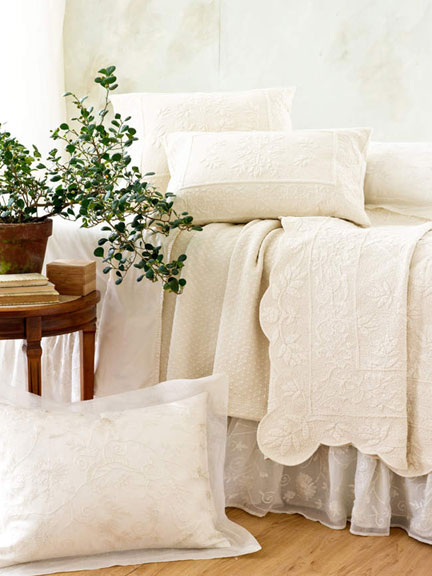
For more registry information and inspiration, visit our Wedding Registry Page.
Guide to Choosing Glassware
Setting the table with the right drinkware is like choosing the right jewelry for an outfit. The glasses will express your personal style, but they’ll also establish the tone and mood of your event.
Glassware Styles
What kinds of glassware are there?
Stemware refers to drinking glasses with a long stem between the bowl and the base. Common pieces include wine glasses and champagne flutes.
Barware includes glasses with solid, flat bases, like highballs and whiskey glasses.
In either case, the shape of each glass is designed to enhance the beverage it holds.
Which glasses should I select for everyday use?
Your everyday glassware should feel comfortable in your hand and be durable, dishwasher-safe, and easy to store. Simon Pearce makes wonderful everyday glasses.
Understanding Glassware Materials
Should I buy glass or lead crystal formal stemware?
It depends on the look you want. Glass is more affordable, but less brilliant. Lead crystal, which is produced by adding 24% red lead oxide to glass, is heavier, more clear, and more brilliant. The addition of the oxide also softens the raw material, so lead crystal can take on more intricate cutwork and designs. High-end stemware is usually made from lead crystal.
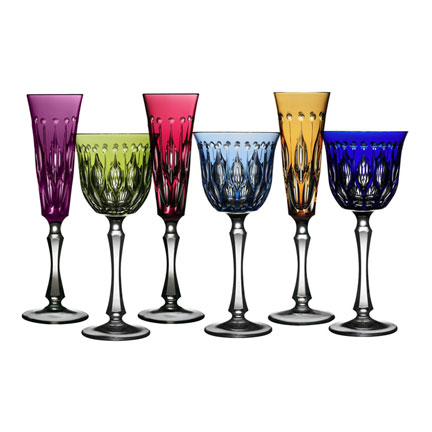
Suggested Quantities
What shapes and quantities should I buy?
At a minimum, we recommend the following:
12 everyday water or juice glasses
12 formal water glasses
12 formal white wine glasses
12 formal red wine glasses
12 champagne flutes
One pitcher
One wine bucket
One wine opener
One ice bucket
What other complimentary pieces do I need?
Other popular options include beer mugs, rocks glasses (like double old fashioned), cocktail glasses (like martini glasses), shot glasses, and brandy snifters. For cocktail parties, additional pitchers, carafes, and decanters are elegant serving items to stock in your bar.
Caring for Glassware
How do I care for my stemware?
Fine stemware should be washed by hand and dried with a lint-free cloth. Never use steel wool or abrasives on your stemware. We do not recommend using the dishwasher for any crystal stemware.

How do I store my stemware?
Stemware should be stored right side up to protect the rims of the glasses from breakage. We recommend placing fine stemware near the backs of your shelves to protect them from accidental handling.

Completing Your Set
How do I lay out my dinnerware and stemware?
Place the presentation plate directly in front of each guest’s chair. Next, set the dinner plate directly on top of the presentation plate. The bread & butter plate should be placed at a 10:00 angle to the dinner plate. The water glass should be at the 1:00 angle from the dinner plate and just above the knives. The wine glass is then placed directly the right and below the water glass, and the champagne flute then further to the right and above the wine glass (thus forming a small triangle).

To view more bar and glassware collections, click here.
Guide to Choosing Pillows
Choosing the right pillow is essential to a good night’s rest. In order to decide which pillow is right for you, there are two factors you need to consider:
1. YOUR FIRMNESS LEVEL
Your specific sleeping style will determine the firmness of your pillow.
– Stomach sleepers should choose a soft, plump pillow to cushion and gently support the head and neck.
– Back sleepers should choose a medium pillow to position the head and neck in line with the natural curvature of the spine.
– Side sleepers should choose a firm pillow to provide more support and properly align the head, neck, and shoulders.

2. YOUR PREFERRED FILL TYPE
Down: Down is nature’s best fill and insulator. The most luxurious pillows are filled with white goose down.
– Because down is so lightweight, it’s one of the most comfortable fills for pillows and comforters.
– Down pillows are shaped for comfort and support and mold to your head and neck.
– The higher the fill power, the higher quality the pillow.
– Down pillows last longer and hold up better than synthetic fills.
– Down breathes well, lifting moisture away from the sleeper.
Down/Feather Blend: Down/feather pillows are firmer than down filled pillows. They are an excellent choice for those who want a firmer support.
Comforel/Down Alternative Fill: A wonderful hypoallergenic microfiber fill that offers down-like comfort, loft and softness, at a more economical price than down. This fill is perfect for sleepers who are allergy prone.
To view our entire selection of down and down alternative pillows, click here.
Guide to Choosing Dinnerware
Selecting a dinnerware collection is an exciting task! With a myriad of options to choose, we at Gracious Style are here to help narrow your search, and find the style that is perfect for you. Whether you are looking for formal china, or fun, everyday essentials, we break down the basics and answer any questions that may arise.
Understanding Dinnerware Materials
What are the different types of materials used to make dinnerware?
Luxury dinnerware is usually made of either porcelain or bone china. Casual dinnerware is made from earthenware or stoneware because these are usually more durable, easier to care for, and lower in price.
– Porcelain: The key ingredient, kaolin, is what makes porcelain so extraordinary. Fired at a the highest temperatures, porcelain combines a stark white appearance with incredible durability to make timeless pieces that will last in beauty and reliability for years to come. Well-known names to consider include Raynaud, Haviland, and Philippe Deshoulieres. And if you appreciate hand-painted porcelain, Herend and Anna Weatherley make beautiful pieces.
Care: Most porcelain items are dishwasher and microwave safe. We recommend hand washing for larger pieces, handpainted collections, or items with gold or platinum decoration. Items with metallic decoration should not be microwaved.
– Bone China: This is a very fine, soft-paste clay that is made from several key ingredients, including bone ash. The result is a beautiful, high translucency white with warm, ivory tones. Considered by many to be the finest quality of china, it has great strength and very high chip-resistance. Brands we suggest: Pickard, Royal Crown Derby.
Care: Most bone china items are dishwasher and microwave safe. We recommend hand washing for larger pieces or items with gold or platinum decoration. Items with metallic decoration should not be microwaved.
– Stoneware: Ideal for casual dining, stoneware is fired at very high temperatures to produce pieces which are durable and quite chip-resistant. Available in a numerous range of colors, some pieces also have beautiful crackled surfaces. Brands we suggest: Gien, Jars, Juliska, Vietri.
Care: Dishwasher, microwave, oven, and freezer safe.
– Earthenware: as it is fired at relatively low temperatures, this type of pottery is more porous and less translucent than either porcelain or bone china. These pieces are relatively thick and heavy, and their natural colors range from from buff to red, depending on the clay used. A much-beloved characteristic of earthenware is that it is likely to crackle as the clay expands and contracts, but this does not affect the use of the piece. Brands we suggest: Vietri.
Care: Dishwasher safe; most are microwave safe on low to medium settings. We recommend avoiding sudden temperature changes.
What is Limoges porcelain?
Limoges refers to a region in France where some of the earliest porcelain pieces were produced as far back as 1765. For centuries, the name Limoges has represented the finest quality and craftsmanship in porcelain throughout the world. Limoges porcelain is very white; most of the best-known producers of French porcelain are based in Limoges.
What are some simple ways to determine quality in dinnerware?
You can determine the quality of porcelain and fine china with a few simple tests:
– Hold the piece up to the light and you should be able to see the shadow of your hand behind the porcelain.
– Flick the plate with your fingers and listen for a resonant ring.
– Examine the color and make sure the glaze is even; the finish should be smooth and lustrous.
Dinnerware Styles
What dinnerware styles are available?
Generally, dinnerware is broken down into casual and formal collections. From there, you can choose between four major styles: solid (meaning one color throughout, with no pattern), banded, patterned, and handpainted.
If you’re looking for something with a monogram or in a specific color, take a look at our custom dinnerware collections.
And for outdoor entertaining, there are also outdoor dinnerware collections available.
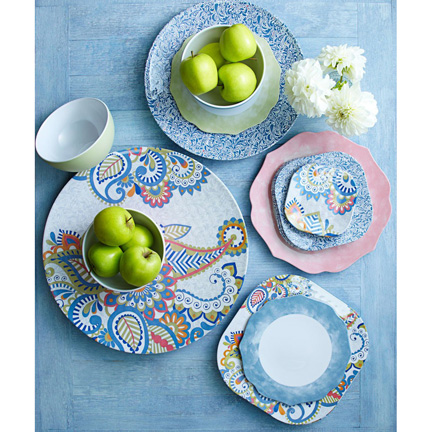
Suggested Quantities
How many dinnerware collections do I need?
In making this decision, we suggest considering the size of your family, the type of entertaining you are most likely to do (formal seated dinners or buffet brunches), and the complexity of your menus. Many people choose to have at least one casual collection for everyday use and one formal collection for selected occasions (usually porcelain).
How many settings do I need?
We recommend registering for twelve five-piece place settings, as these will see you through most dinner parties. These five-piece settings typically include a dinner plate, salad or dessert plate, bread and butter plate, tea cup, and tea saucer. On more casual collections, you will sometimes see four-piece settings available. These normally include a dinner plate, salad plate, bowl, and mug. While you may not always be entertaining for twelve, having additional pieces will guarantee that you have spares when items break or unexpected guests show up. From time to time, collections or specific pieces do get discontinued, so if you love a piece, buy it while you can.
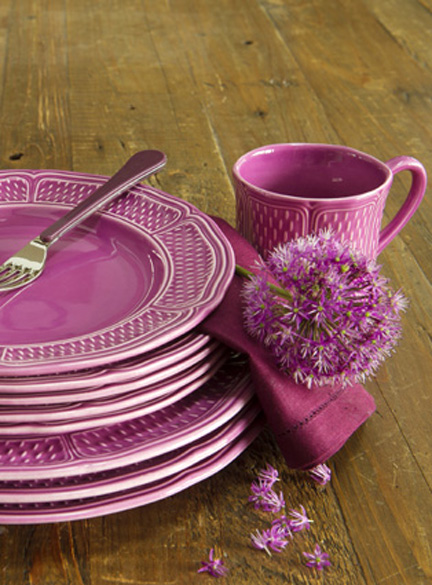
What is included in a five-piece place setting?
A five-piece formal setting consists of a dinner plate, salad plate, bread/butter plate, teacup, and saucer.
What is included in a four-piece place setting?
On more casual collections, you will sometimes see four-piece settings available. These normally include a dinner plate, salad plate, bowl, and mug.
What are standard dinnerware sizes?
Sizes sometimes vary slightly among different collections, but they are generally as follows:
| Presentation Plate | 12″ diameter |
| Dinner Plate | 10.5″ diameter |
| Dessert Plate | 8.5″ diameter |
| Salad Plate | 7.5″ diameter |
| Bread/Butter Plate | 6.75″ diameter |
What is a presentation plate?
Also known as chargers or buffet plates, presentation plates are oversized plates (12″ diameter) designed to add color and style to your table setting. These are usually removed before the main course is served, although they are also frequently used as buffet dinner plates since they can hold larger quantities of food.
What kinds of serving pieces do I need?
When registering for dinnerware, it is easy to overlook serving pieces. However, these items are not only great for unifying your collection, they are necessities that will be essential for cooking, entertaining, and everyday dining. We recommend the following as a starting point:
– Two to three serving dishes
– Two serving bowls or salad bowls
– One covered casserole dish
– One cake platter (or better yet, a cake stand for a better presentation)
– One tea and/or coffee service (this should include the teapot or coffee pot, creamer, and sugar bowl)
Caring for Dinnerware
How do I care for my dinnerware?
Most dinnerware items are microwave and dishwasher safe, unless they are decorated with gold or silver. We recommend hand washing for larger pieces, handpainted collections, or items with gold or platinum decoration. Items with metallic decoration should not be microwaved.
Monogramming
How should I monogram my dinnerware?
If you choose to have your dinnerware monogrammed, consider several different options. Single-letter monograms usually feature the first initial of the last name. On three-letter monograms, most individuals choose to have their first, middle, and last or first, last, and middle initials embroidered. For married couples, a popular choice is the initials of the couple’s first names on either side of their married last name.
Would you like to see more styles? Click here to view all our dinnerware collections.
Guide to Choosing Down
Ever wonder why a down blanket or comforter is so warm and comfy on a cold winter night? It’s because they’re made from one of nature’s best insulating materials. Tucked safely under the long feathers of ducks and geese, down is actually many soft, fluffy plumules which connect with each other through thousands of strands of fiber. As these plumules connect with each other, they create little pockets of warm air which provide an incredible amount of insulation without a lot of weight.
If you’re thinking about investing in a down comforter or pillow, here are some basics to keep in mind.
Understanding Down Basics
What is down?
Down clusters, often simply referred to as down, are the three-dimensional plumage found under the belly feathers of ducks and geese. They are nature’s finest insulation, allowing waterfowl to remain warm even in the most frigid environments. Down clusters have a center core with fibers extending outward from the core, but unlike feathers there is no spine. The three-dimensional quality traps air and maintains warmth without a great deal of weight. Down is very breathable and allows moisture to evaporate quickly.
What are feathers?
Feathers are the plumage found on the outside of waterfowl; they have a two-dimensional quality with a shaft running vertically through the feather. The contoured shape of feathers provides a supportive quality which makes them appropriate for use in sleeping pillows, decorative pillow inserts and feather beds. They are generally not used for insulating purposes.
What is fill power?
Fill power is a numerical designation for the volume one ounce of down occupies. The higher the value, the more volume the one ounce will occupy. Fill power also provides an index for determining the lofting, insulation properties and quality of the down.

Fill power is directly related to the size of the down cluster. Large down clusters occupy more space than smaller down clusters, and they trap more air between the clusters. This trapped air is what gives down its insulating properties.
The size of the bird and the climate in which it lives determines the size of its down cluster. The colder climate, the larger the down cluster required to keep the bird warm. For example, it is colder in Canada than it is in Hungary; therefore, Canadian birds need larger down clusters in order to stay warm.
What kinds of shell materials are used for down bedding?
Like with all bedding, both thread count and material are important for the fabric shell of the duvet and pillow cover, because they determine how the item feels against you.
But for down items, the fabric shell has added importance: this is what keeps the down inside and potential allergens, dust, and bacteria out. A higher thread count fabric shell will protect your down better and keep it cleaner. The most common down covers are made from cotton; silk and eco-friendly materials are also available.
Are there alternatives to down?
If you’re allergic to down, there many options made from synthetic, hypoallergenic material designed to imitate the clusters of natural down.
Choosing the Right Comforter
It’s easy to find a comforter that’s just right for you. For an unparalleled sleeping experience, you should consider these two factors:
1. YOUR LEVEL OF WARMTH
To select the ideal comforter, you should consider such factors as season, climate, heating system and thermostat setting. Most of our classic comforters are now offered in three weights to best suit your needs.
Summer Weight: Ideal for the warm sleeper, warm climates or when the room temperature is above 70°F.
All Year Weight: The most popular choice, this all-season comforter is perfect for year-round use and for those who keep their bedroom temperature between 60°F and 65°F.
Winter Weight: Ideal for the cold sleeper, cool bedrooms, very cold climates and for those who prefer extra warmth during the winter season.
2. YOUR LEVEL OF QUALITY
Comforters are available with different qualities of fills and shells. The most affordable generally feature more common fills and lower thread count shells, while the most expensive use rare, exotic fills and finer fabrics.
Introductory: Our most affordable down comforters features a 233 thread count cover filled with 560 fill power white down (example: Mackenza comforters)

Classic: These classics feature a soft, 300 thread count cover filled with high loft, and 600 fill power white goose down, guaranteed to provide many years of warmth and pleasure (examples: Cascada Summit, 3-in-1 Anytime, and Buxton comforters)

Best Value: Opting for lasting comfort and value? The comforters in this class offer remarkable quality and sumptuous softness. A high quality white goose down with large and plump clusters, our 650 and 700 fill power white goose downs, provide luxurious warmth with minimum weight. Choice of 330 or 383 thread count cotton sateen gives the finishing touch to this amazing selection (example: Nirvana, Continental, and Somerset comforters).

Supreme: Exceptional superiority, the 700 and 800 fill power is one of the word’s finest downs. Premium clusters of down deliver superior loft and maximum warmth with minimal weight. Moreover, our silky smooth downproof fabric is made in Europe using the exclusive SanProCare process, known to enhance temperature regulation, absorption and release of moisture, and superior durability (examples: Bernina, Himalaya, and Cardigan comforters).

Ultimate: When only the very best will do; our most magnificent comforters offer unparalleled luxury, warmth and craftsmanship. The very largest, softest 920 fill power Siberian, Canadian white goose down, or Eiderdown paired with a choice of Batiste lightweight fabric- or our 100% Pure Silk, Flowering Vine pattern cover, introduce you to the incredible lightness of warmth. These opulent comforters result in extraordinary comfort and promise luscious sleep for years to come (examples: Logana, Eliasa, Snowdon comforters).

Down Alternative: Filled with Comforel, Innofil, and other similar fibers, these hypoallergenic microfiber fills offer down-like comfort, loft and softness at a more economical price than down. Perfect for sleepers who are allergy prone (examples: Sierra, Astra, Arcadia, and Anti-Allergy Down comforters).

Tencel Ecofriendly: The combination of high quality 650 fill power white goose down and a Tencel® lyocell cover offers you easy-care comfort that’s soft on you and the environment. Tencel® lyocell is a natural fabric manufactured from wood pulp from Eucalyptus trees, which is extremely silky to the touch, has a very soft finish and is noted for its durability, light weight and strength (example: Innutia comforters).

What are the different kinds of comforter construction?
Comforter construction provides the performance features and aesthetic appearance of a comforter.
– Baffle boxstitch construction utilizes vertical walls of fabric between each box; allowing the fill to achieve its greatest loft and a smoother surface texture.
– Sewn-thru boxstitch construction features end-to-end closed boxes that are stitched closed to prevent shifting of the fill material. The box shape is more visible because the top and bottom layers of fabric are sewn together.


These baffle boxes actually have an important job: In addition to giving the duvet a puffy checkered quilting, they help keep the down remain evenly distributed throughout the duvet cover. Otherwise, the down feathers may fall to the bottom or sides of the duvet, leaving the center cold and empty.
Choosing the Right Pillow
Choosing the right pillow is essential to a good night’s rest. In order to decide which pillow is right for you, there are two factors you need to consider:
1. YOUR FIRMNESS LEVEL
Your specific sleeping style will determine the firmness of your pillow.
– Stomach sleepers should choose a soft, plump pillow to cushion and gently support the head and neck.
– Back sleepers should choose a medium pillow to position the head and neck in line with the natural curvature of the spine.
– Side sleepers should choose a firm pillow to provide more support and properly align the head, neck, and shoulders.

2. YOUR PREFERRED FILL TYPE
Down: Down is nature’s best fill and insulator. The most luxurious pillows are filled with white goose down.
– Because down is so lightweight, it’s one of the most comfortable fills for pillows and comforters.
– Down pillows are shaped for comfort and support and mold to your head and neck.
– The higher the fill power, the higher quality the pillow.
– Down pillows last longer and hold up better than synthetic fills.
– Down breathes well, lifting moisture away from the sleeper.
Down/Feather Blend: Down/feather pillows are firmer than down filled pillows. They are an excellent choice for those who want a firmer support.
Comforel/Down Alternative Fill: A wonderful hypoallergenic microfiber fill that offers down-like comfort, loft and softness, at a more economical price than down. This fill is perfect for sleepers who are allergy prone.
What are the different kinds of pillow construction?
Sleeping pillows are generally constructed using either single chamber or multi-chambered compartmented shells.
– Single construction pillows place the fill material in one area. The fill options for single chambered construction include down, feather/down blends, and down alternative fibers.
– Multi-Chambered compartmented construction provides multiple internal chambers for housing the fill material. For example, some pillows feature feather cores surrounded by down exteriors.
Caring for Down
How do you care for down comforters and pillows?
With proper care, your down comforters and pillows should last many years.
– Pillows and comforters should always be used inside a cover. For additional protection, pillows should be used with a pillow protector.
– Fluff your pillows and comforters every day when you make your bed.
– Comforters may be spot cleaned for spills and aired out occasionally.
– While frequent washing is not advised, down products may either be washed or dry cleaned. Dry cleaning should only be performed by a company experienced with down products, as dirty cleaning fluid will cause the down to clump, lose its lofting ability and occasionally develop a mild odor.
– Wash in a front-loading commercial capacity washer. Avoid machines with agitators, as these are too rough and can tear the baffles.

– Use a low sudsing detergent or a product specifically designed for washing down products (like Le Blanc Down Wash). Do not use bleach or fabric softener.

– Run through the rinse cycle twice to remove all soap.
– Place in large capacity dryer on the lowest heat setting and dry for 3-4 hours. If you’d like, place a couple of clean tennis or dryer balls inside the dryer to help fluff the down. Dry well beyond the point where the outer fabric feels dry, as you want to make sure that the down clusters are fully dry.
– Allow the comforter to air dry for an additional 24 hours before placing it inside a duvet cover. If you notice any lingering odors or clumping, place it in the dryer again and continue to dry it.
– We do not recommend cleaning down more than twice a year.
Want to learn more? To shop for down, click here to view all our down and down alternative products. To shop for cleaning solutions, click here to view our down and linen care products.
Product Review: Le Blanc Specialty Laundry Products
At Gracious Style, we are introduced to some of the most luxurious materials on a daily basis. It’s our job to find the best of the best, whether it’s Giza 45 Egyptian Cotton sheets, or hand-embroidered Italian table linens. Given the quality of the products we love, we know that proper care and cleaning are essential for long-lasting, sumptuous fibers. We’ve personally tested Le Blanc’s specialty cleansers in our own homes, and here’s what we have to say.

What You Should Know:
- Le Blanc products are environmentally safe. They are 100% biodegradable, contain no bleach, have a neutral pH balance, and are not tested on animals. This makes them safe for cleaning delicate materials like lace, silk, linen, and down.
- The detergents are triple concentrated. 1/4 cup is all that is needed for a full load of laundry. “I love that you only use 2 ounces of liquid per load; my bottle lasted me several months!” – Carolina
- Le Blanc products are energy-efficient. All of the cleansers work with cold water, and can be used in a variety of washing machines.
- Le Blanc formulas have been tested to remove stains caused by lipstick, jam, fruit juice, coffee, tea, chocolate, wine, grease, blood, cola, ink and even certain oils.
Le Blanc Offerings:
Linen Press – designed to leave a silky hand and polished finish on table and bed linens. Press fine fabrics and create a protective layer to guard against new stains. This non-aerosol formula ensures a wrinkle-free sheen, and features an easy spray nozzle.
Linen Wash – Le Blanc’s premium cold-water cleanser is proven to be the safest in the home textile industry. The detergent removes tough stains from fabrics without the use of harmful chemicals. It is mild enough to care for linen, cotton, sateen, and percale, making it ideal for use on bedding and table cloths. “The Linen Wash really works well for pretreating stains. After our Thanksgiving dinner, I quickly poured a few drops on our napkins and tablecloths, and the stains were gone when I did the laundry the next day.” – Carolina
Silk & Lingerie Wash – Designed for all washable and colorfast delicate fabrics. The specialized formula protects elasticity, preserves shape, and gently launders swim and active wear, hosiery and intimate apparel, wool and cashmere sweaters, and silk bedding and table linens. “No need to buy scented sachets to stick in my underwear and sock drawers anymore. The articles smell so fresh after, they scent the whole drawer” – Nicole.
Towel Wash – formulated to clean luxury bath towels, mats, rugs, and cotton terry robes while protecting fibers from drying out. Even after repeated wash cycles, bath linens are guaranteed to remain soft, strong, and absorbent. “Washing my towels in the Summer Verbena Towel Wash made a remarkable difference. They were soft to the touch and smelled amazing, which I expected would happen, but I was nervous they wouldn’t look as clean. I was proven wrong; no makeup stains, nothing! Worked like a charm for my white towels” – Nicole.
Laundry Wash – For use on all types of apparel made from natural and synthetic fibers. Fabrics are disinfected while colors and shapes are preserved. Whites and darks alike will smell fresh and look renewed. “Doing laundry is now more fun, and our linens smell really good” – Carolina.
Downwash – Specifically designed for laundering down-filled, down alternative, and hypoallergenic materials without altering its capacity for natural insulation. This wash protects down’s loft by preventing its naturally resilient oils from becoming brittle. “So nice that I can wash my down comforter at home now.” – Carolina.
Fragrance Infusion – This alternative to traditional fabric softener can be added to the rinse cycle to reduce static cling and add extra fragrance. As this product contains no optical brighteners, and will not stain or clog, it is safe for use in all washing machines. “I’ve been hearing more and more about the disadvantages of using fabric softeners. This is an excellent, safer alternative” – Nicole.
Dryer Sachets – These should be used in place of polyester dryer sheets to prevent pilling of luxury linens. Filled with unique fragrances, the sachets scent articles in the dryer or in a drawer. Each one can be reused for a minimum of sixteen cycles. “I use these in my closets to scent up the whole space” – Carolina.
Linen Waters – Perfect for misting household linens and fabrics like bed sheets, drapery, towels, and more. The formula will not stain and is guaranteed to leave a lasting aroma.

Spotlight on Scents:
Original: “A very sweet, fruity and floral scent. The apple, hyacinth, and sandalwood are the most prevalent notes” – Eve. “Sweet like candy but charmingly light. The fusion of jasmine, kiwi, grapefruit, and musk are refreshing” – Nicole.
Fields of Green: “Floral, but fresher than the original scent, this one has a slighter brighter fragrance to it, with more of a citrusy garden blend” – Eve. “Reminds me of fresh cut grass, and spring” – Nicole.
Children’s Wash (Pink and Purple): “Light and happy, like a cloud on a spring day” – Si. “This is a milder, lighter version of the Original scent” – Carolina.
Lavender: “Like a field in Provence” – Carolina. “Very classic, herbal scent with subtle notes of mint” – Eve. “Lavender is of course a calming aroma. This fragrance will sooth the senses and coat your linens in a blanket of tranquil freshness. Very ladylike” – Nicole.
Silk Petals Silk & Lingerie: “A signature floral scent, this mixes the sweet smells of rose with gardenia” – Eve. “Floral, feminine, and delicate, the blend of lilac, rose, and gardenia is delightfully sophisticated” – Nicole. “Powdery and feminine” – Carolina.
Blue Violet: “Light, clear, and fresh” – Si. “Clean, crisp, and soapy (in the best way!), with light floral notes” – Nicole.
Summer Verbena: “Primarily citrus, with a hint of floral” – Eve. “After washing my bedding in this scent, my entire bedroom smelled of a lovely citrus, but the scent was never overwhelming” – Nicole.
Portfolio: “My personal favorite! This is a more masculine scent, but the women in our office loved it equally as much. This is a woodsy, musky scent with notes of amber and vanilla” – Eve. “Serious and sophisticated” – Si. “Designed for the modern day male, this scent is universally appealing and alluring. The blend of woods and orange blossom, with hints of vanilla, make it an ideal unisex fragrance” – Nicole.
For more Le Blanc, click here!
Guide to Choosing Comforters
It’s easy to find a comforter that’s just right for you. For an unparalleled sleeping experience, you should consider these two factors:
1. YOUR LEVEL OF WARMTH
To select the ideal comforter, you should consider such factors as season, climate, heating system and thermostat setting. Most of our classic comforters are now offered in three weights to best suit your needs.
Summer Weight: Ideal for the warm sleeper, warm climates or when the room temperature is above 70°F.
All Year Weight: The most popular choice, this all-season comforter is perfect for year-round use and for those who keep their bedroom temperature between 60°F and 65°F.
Winter Weight: Ideal for the cold sleeper, cool bedrooms, very cold climates and for those who prefer extra warmth during the winter season.
2. YOUR LEVEL OF QUALITY
Comforters are available with different qualities of fills and shells. The most affordable generally feature more common fills and lower thread count shells, while the most expensive use rare, exotic fills and finer fabrics.
Introductory: Our most affordable down comforters features a 233 thread count cover filled with 560 fill power white down (example: Mackenza comforters)

Classic: These classics feature a soft, 300 thread count cover filled with high loft, and 600 fill power white goose down, guaranteed to provide many years of warmth and pleasure (examples: Cascada Summit, 3-in-1 Anytime, and Buxton comforters)

Best Value: Opting for lasting comfort and value? The comforters in this class offer remarkable quality and sumptuous softness. A high quality white goose down with large and plump clusters, our 650 and 700 fill power white goose downs, provide luxurious warmth with minimum weight. Choice of 330 or 383 thread count cotton sateen gives the finishing touch to this amazing selection (example: Nirvana, Continental, and Somerset comforters).

Supreme: Exceptional superiority, the 700 and 800 fill power is one of the word’s finest downs. Premium clusters of down deliver superior loft and maximum warmth with minimal weight. Moreover, our silky smooth downproof fabric is made in Europe using the exclusive SanProCare process, known to enhance temperature regulation, absorption and release of moisture, and superior durability (examples: Bernina, Himalaya, and Cardigan comforters).

Ultimate: When only the very best will do; our most magnificent comforters offer unparalleled luxury, warmth and craftsmanship. The very largest, softest 920 fill power Siberian, Canadian white goose down, or Eiderdown paired with a choice of Batiste lightweight fabric- or our 100% Pure Silk, Flowering Vine pattern cover, introduce you to the incredible lightness of warmth. These opulent comforters result in extraordinary comfort and promise luscious sleep for years to come (examples: Logana, Eliasa, Snowdon comforters).

Down Alternative: Filled with Comforel, Innofil, and other similar fibers, these hypoallergenic microfiber fills offer down-like comfort, loft and softness at a more economical price than down. Perfect for sleepers who are allergy prone (examples: Sierra, Astra, Arcadia, and Anti-Allergy Down comforters).

Tencel Ecofriendly: The combination of high quality 650 fill power white goose down and a Tencel® lyocell cover offers you easy-care comfort that’s soft on you and the environment. Tencel® lyocell is a natural fabric manufactured from wood pulp from Eucalyptus trees, which is extremely silky to the touch, has a very soft finish and is noted for its durability, light weight and strength (example: Innutia comforters).

To view our entire selection of down pillows and comforters, click here.

